Breaking Down Linear Low-Density Polyethylene (LLDPE) Using Fungal Mycelium (Part A): A Path Towards Sustainable Waste Management and Its Possible Economic Impacts
Abstract
1. Introduction
2. Materials and Methods
2.1. Source of Fungal Strains and Their Preparation
2.2. Preparation of LLDPE Sheets
2.3. Screening the Potential of Each Fungal Mycelium for Expansion
2.4. Determination of Ligninolytic Activity Using Agar Plate Assay
2.5. Biodegradation of the LLDPE Sheets
2.6. Measuring Mass Lost
2.7. Surface Morphology Observations of LLDPE Sheets
2.8. Fourier Transformed Infrared (FTIR) Spectroscopic Analysis
2.9. Statistical Analysis
3. Results and Discussions
3.1. The Potential of Fungal Mycelium Expansion
3.2. Screening of Fungi for Ligninolytic Activity Using Agar Plate Assay
3.3. Weight Loss Measurement
3.4. Surface Morphology of LLDPE Sheets
3.5. FTIR Analysis
3.6. Cost Effectiveness and Economic Impact in Management
3.7. Future Perspectives and Further Activities
4. Conclusions
Author Contributions
Funding
Institutional Review Board Statement
Informed Consent Statement
Data Availability Statement
Acknowledgments
Conflicts of Interest
References
- Wojnowska-Baryła, I.; Bernat, K.; Zaborowska, M. Plastic waste degradation in landfill conditions: The problem with microplastics, and their direct and indirect environmental effects. Int. J. Environ. Res. Public Health 2022, 19, 13223. [Google Scholar] [CrossRef] [PubMed]
- Kaiser, K.; Schmid, M.; Schlummer, M. Recycling of polymer-based multilayer packaging: A review. Recycling 2017, 3, 1. [Google Scholar] [CrossRef]
- Cai, Z.; Li, M.; Zhu, Z.; Wang, X.; Huang, Y.; Li, T.; Li, T.; Gong, H.; Yan, M. Biological degradation of plastics and microplastics: A recent perspective on associated mechanisms and influencing factors. Microorganisms 2023, 11, 1661. [Google Scholar] [CrossRef] [PubMed]
- Evode, N.; Qamar, S.A.; Bilal, M.; Barceló, D.; Iqbal, H.M. Plastic waste and its management strategies for environmental sustainability. Case Stud. Chem. Environ. Eng. 2021, 4, 100142. [Google Scholar] [CrossRef]
- Kumar, R.; Verma, A.; Shome, A.; Sinha, R.; Sinha, S.; Jha, P.K.; Kumar, R.; Kumar, P.; Shubham; Shreyas , D. Impacts of plastic pollution on ecosystem services, sustainable development goals, and need to focus on circular economy and policy interventions. Sustainability 2021, 13, 9963. [Google Scholar] [CrossRef]
- Srivastava, D. Fungi based bio-remediation: Revolutionizing plastic waste management for sustainability. Int. Res. J. Biol. Sci. 2024, 13, 39–45. [Google Scholar]
- Bautista-Zamudio, P.A.; Flórez-Restrepo, M.A.; López-Legarda, X.; Monroy-Giraldo, L.C.; Segura-Sánchez, F. Biodegradation of plastics by white rot fungi: A review. Sci. Total Environ. 2023, 901, 165950. [Google Scholar] [CrossRef]
- Dinakarkumar, Y.; Gnanasekaran, R.; Reddy, G.K.; Vasu, V.; Balamurugan, P.; Murali, G. Fungal bioremediation: An overview of the mechanisms, applications and future perspectives. Environ. Chem. Ecotoxicol. 2024, 6, 293–302. [Google Scholar] [CrossRef]
- Temporiti, M.E.E.; Nicola, L.; Nielsen, E.; Tosi, S. Fungal enzymes involved in plastics biodegradation. Microorganisms 2022, 10, 1180. [Google Scholar] [CrossRef]
- Zhang, J.; Gao, D.; Li, Q.; Zhao, Y.; Li, L.; Lin, H.; Zhao, Y. Biodegradation of polyethylene microplastic particles by the fungus Aspergillus flavus from the guts of wax moth Galleria mellonella. Sci. Total Environ. 2020, 704, 135931. [Google Scholar] [CrossRef]
- Gómez-Méndez, L.D.; Moreno-Bayona, D.A.; Poutou-Piñales, R.A.; Salcedo-Reyes, J.C.; Pedroza-Rodríguez, A.M.; Vargas, A.; Bogoya, J.M. Biodeterioration of plasma pretreated LDPE sheets by Pleurotus ostreatus. PLoS ONE 2018, 13, e0203786. [Google Scholar] [CrossRef] [PubMed]
- Sowmya, H.V.; Krishnappa, M.; Thippeswamy, B. Degradation of polyethylene by Trichoderma harzianum—SEM, FTIR, and NMR analyses. Environ. Monit. Assess. 2014, 186, 6577–6586. [Google Scholar] [CrossRef] [PubMed]
- Perera, P.; Deraniyagala, A.S.; Mahawaththagea, M.P.S.; Herath, H.; Rajapakse, C.S.K.; Wijesinghe, P.; Attanayake, R.N. Decaying hardwood associated fungi showing signatures of polyethylene degradation. BioResources 2021, 16, 7056. [Google Scholar] [CrossRef]
- Hassinger, D.A. Utilizing Natural Components to Combat Anthropogenic Effects: Biodegradation of Single-Use Plastics by White-Rot Fungi. Master’s Thesis, Rutgers University, New Brunswick, NJ, USA, May 2018. [Google Scholar]
- Corti, A.; Sudhakar, M.; Chiellini, E. Assessment of the whole environmental degradation of oxo-biodegradable linear low density polyethylene (LLDPE) films designed for mulching applications. J. Polym. Environ. 2012, 20, 1007–1018. [Google Scholar] [CrossRef]
- Bertolacci, L.; Goldoni, L.; Zych, A.; Athanassiou, A. Biocatalytic oxidation of polyethylene by Agrocybe aegerita mycelium. Polym. Degrad. Stab. 2022, 199, 109911. [Google Scholar] [CrossRef]
- Gong, Z.; Jin, L.; Yu, X.; Wang, B.; Hu, S.; Ruan, H.; Sung, Y.-J.; Lee, H.-G.; Jin, F. Biodegradation of low density polyethylene by the fungus Cladosporium sp. recovered from a landfill site. J. Fungi 2023, 9, 605. [Google Scholar] [CrossRef]
- Khruengsai, S.; Sripahco, T.; Pripdeevech, P. Low-density polyethylene film biodegradation potential by fungal species from Thailand. J. Fungi 2021, 7, 594. [Google Scholar] [CrossRef]
- Aiduang, W.; Suwannarach, N.; Kumla, J.; Thamjaree, W.; Lumyong, S. Valorization of agricultural waste to produce myco-composite materials from mushroom mycelia and their physical properties. Agric. Nat. Resour. 2022, 56, 1083–1090. [Google Scholar]
- Kalaw, S.P.; Alfonso, D.O.; Dulay, R.M.R.; De Leon, A.M.; Undan, J.Q.; Undan, J.R.; Reyes, R.G. Optimization of culture conditions for secondary mycelial growth of wild macrofungi from selected areas in Central Luzon, Philippines. Curr. Res. Environ. Appl. Mycol. 2016, 6, 277–287. [Google Scholar] [CrossRef]
- D’Souza, D.T.; Tiwari, R.; Sah, A.K.; Raghukumar, C. Enhanced production of laccase by a marine fungus during treatment of colored effluent and synthetic dyes. Enzym. Microb. Technol. 2006, 38, 504–511. [Google Scholar] [CrossRef]
- Kuwahara, M.; Glenn, J.; Morgan, M.; Gold, M.S. Separation and characterization of two extracellular H2O2-dependent oxidases from ligninolytic cultures of Phanerochaete chrysosporium. FEBS Lett. 1984, 169, 247–250. [Google Scholar] [CrossRef]
- Ali, M.I.A.; Khalil, N.M.; El-Ghany, M.N.A. Biodegradation of some polycyclic aromatic hydrocarbons by Aspergillus terreus. Afr. J. Microbiol. Res. 2012, 6, 3783–3790. [Google Scholar]
- Lechuga, E.G.O.; Zapata, I.Q.; Niño, K.A. Detection of extracellular enzymatic activity in microorganisms isolated from waste vegetable oil contaminated soil using plate methodologies. Afr. J. Biotechnol. 2016, 15, 408–416. [Google Scholar]
- Gao, W.; Xu, M.; Zhao, W.; Yang, X.; Xin, F.; Dong, W.; Jia, H.; Wu, X. Microbial degradation of (micro) plastics: Mechanisms, enhancements, and future directions. Fermentation 2024, 10, 441. [Google Scholar] [CrossRef]
- Ibrahim, S.S.; Ionescu, D.; Grossart, H.P. Tapping into fungal potential: Biodegradation of plastic and rubber by potent fungi. Sci. Total Environ. 2024, 934, 173188. [Google Scholar] [CrossRef]
- Okal, E.J.; Heng, G.; Magige, E.A.; Khan, S.; Wu, S.; Ge, Z.; Zhang, T.; Mortimer, P.E.; Xu, J. Insights into the mechanisms involved in the fungal degradation of plastics. Ecotoxicol. Environ. Saf. 2023, 262, 115202. [Google Scholar] [CrossRef] [PubMed]
- Patel, C.J.; Kansagara, R.H.; Modi, D.V.; Dudhat, N.J.; Sojitra, K.H.; Babaria, D.M. Microbes breaking down plastic: Insights for sustainable waste management. Nat. Environ. Pollut. 2024, 23, 1717–1722. [Google Scholar] [CrossRef]
- Pugh, G.J.F. Strategies in fungal ecology. Trans. Br. Mycol. Soc. 1980, 75, 1–14. [Google Scholar] [CrossRef]
- Boddy, L.; Hiscox, J. Fungal ecology: Principles and mechanisms of colonization and competition by saprotrophic fungi. Microbiol. Spectr. 2016, 4, 10–1128. [Google Scholar] [CrossRef]
- Yang, W.K.; Gong, Z.; Wang, B.T.; Hu, S.; Zhuo, Y.; Jin, C.Z.; Jin, L.; Lee, H.G.; Jin, F.J. Biodegradation of low-density polyethylene by mixed fungi composed of Alternaria sp. and Trametes sp. isolated from landfill sites. BMC Microbiol. 2024, 24, 321. [Google Scholar] [CrossRef]
- Kirk, T.K.; Farrell, R.L. Enzymatic “combustion”: The microbial degradation of lignin. Ann. Rev. Microbiol. 1987, 41, 465–505. [Google Scholar] [CrossRef] [PubMed]
- Viswanath, B.; Rajesh, B.; Janardhan, A.; Kumar, A.P.; Narasimha, G. Fungal laccases and their applications in bioremediation. Enzym. Res. 2014, 2014, 163242. [Google Scholar] [CrossRef]
- Wong, D.W. Structure and action mechanism of ligninolytic enzymes. Appl. Biochem. Biotechnol. 2009, 157, 174–209. [Google Scholar] [CrossRef] [PubMed]
- Hyder, A.; Khan, M.; Khan, S.; Iqbal, M.; Jan, S.A.; Shah, S.H.; Abdullah; Rahman, Z.; Iqbal, U. Biodegradation of low-density polyethylene plastics by fungi isolated from waste disposal site at district Peshawar, Pakistan. Pak. J. Biochem. Biotechnol. 2021, 2, 127–133. [Google Scholar]
- Sathiyabama, M.; Boomija, R.V.; Sathiyamoorthy, T.; Mathivanan, N.; Balaji, R. Mycodegradation of low-density polyethylene by Cladosporium sphaerospermum, isolated from platisphere. Sci. Rep. 2024, 14, 8351. [Google Scholar] [CrossRef] [PubMed]
- Dailin, D.J.; Rithwan, F.; Hisham, A.M.; Rasid, Z.I.A.; Azelee, N.I.W.; Sapawe, N.; Chuah, L.F.; Yusof, A.H.M.; Enshasy, H.E. A Review on current status of plastic waste biodegradation using microbial approach. Biosci. Res. 2022, 19, 1599–1606. [Google Scholar]
- Sangale, M.K.; Shahnawaz, M.; Ade, A.B. Potential of fungi isolated from the dumping sites mangrove rhizosphere soil to degrade polythene. Sci. Rep. 2019, 9, 5390. [Google Scholar] [CrossRef] [PubMed]
- Jung, M.R.; Horgen, F.D.; Orski, S.V.; Rodriguez, V.C.; Beers, K.L.; Balazs, G.H.; Jones, T.T.; Work, T.M.; Brignac, K.C.; Royer, S.-J.; et al. Validation of ATR FT-IR to identify polymers of plastic marine debris, including those ingested by marine organisms. Mar. Pollut. Bull. 2018, 127, 704–716. [Google Scholar] [CrossRef]
- Meléndez-Pérez, R.; Rodríguez-Hernández, Y.; Arjona-Román, J.L.; Méndez-Albores, A.; Coria-Hernández, J. Frost formation in frozen meat packaged with two plastic films (LDPE and PVC). Processes 2022, 10, 2415. [Google Scholar] [CrossRef]
- Lu, S.M. Resource recycling and waste-to-energy: The cornerstones of circular economy. Int. J. Innov. Technol. Manag. 2018, 2, 4–22. [Google Scholar] [CrossRef]
- Nikiema, J.; Asiedu, Z. A review of the cost and effectiveness of solutions to address plastic pollution. Environ. Sci. Pollut. Res. 2022, 29, 24547–24573. [Google Scholar] [CrossRef] [PubMed]
- Gradus, R.H.; Nillesen, P.H.; Dijkgraaf, E.; Van Koppen, R.J. A cost-effectiveness analysis for incineration or recycling of Dutch household plastic waste. Ecol. Econ. 2017, 135, 22–28. [Google Scholar] [CrossRef]
- Pilapitiya, P.N.T.; Ratnayake, A.S. The world of plastic waste: A review. Clean. Mater. 2024, 11, 100220. [Google Scholar] [CrossRef]
- Huang, S.; Wang, H.; Ahmad, W.; Ahmad, A.; Ivanovich Vatin, N.; Mohamed, A.M.; Deifalla, A.F.; Mehmood, I. Plastic waste management strategies and their environmental aspects: A scientometric analysis and comprehensive review. Int. J. Environ. Res. Public Health 2022, 19, 4556. [Google Scholar] [CrossRef]
- Pandey, P.; Dhiman, M.; Kansal, A.; Subudhi, S.P. Plastic waste management for sustainable environment: Techniques and approaches. Waste Dispos. Sustain. Energy 2023, 5, 205–222. [Google Scholar] [CrossRef] [PubMed]
- Kibria, M.G.; Masuk, N.I.; Safayet, R.; Nguyen, H.Q.; Mourshed, M. Plastic waste: Challenges and opportunities to mitigate pollution and effective management. Int. J. Environ. Res. 2023, 17, 20. [Google Scholar] [CrossRef]
- Brassil, T. Calls for Action as Australia’s Plastic Pollution Continues to Rise. Available online: https://www.uowtv.com/calls-for-action-as-australias-plastic-pollution-continues-to-rise/ (accessed on 20 January 2025).
- McKenna, J. Using Fungi for Waste Management. Available online: https://blog.mdpi.com/2023/12/12/fungi-for-waste-management/ (accessed on 20 January 2025).
- Khatun, M.M.; Rahman, M.M.; Showva, N.N. Plastic waste management through biological methods: An approach towards sustainable development. Commun. Biol. 2024, 10, 1597–1608. [Google Scholar] [CrossRef]
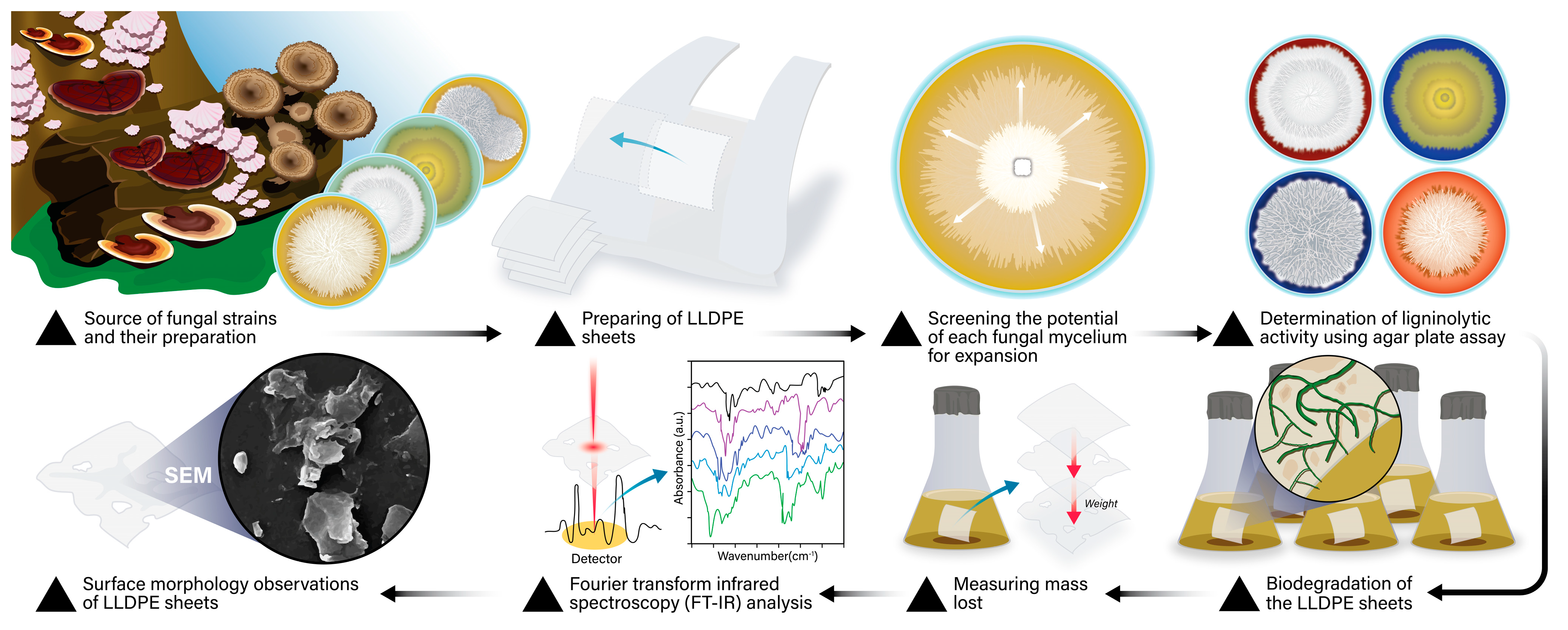
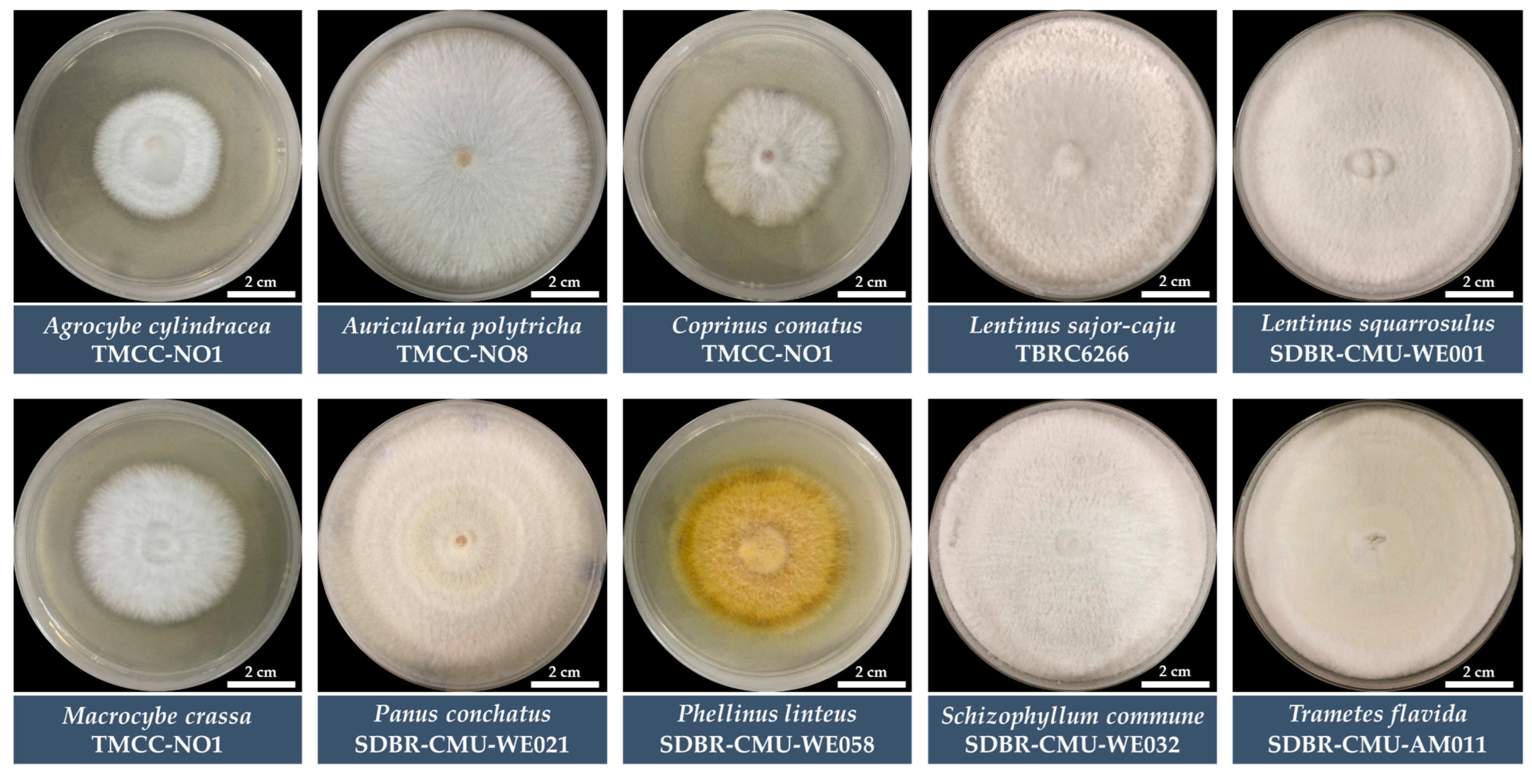
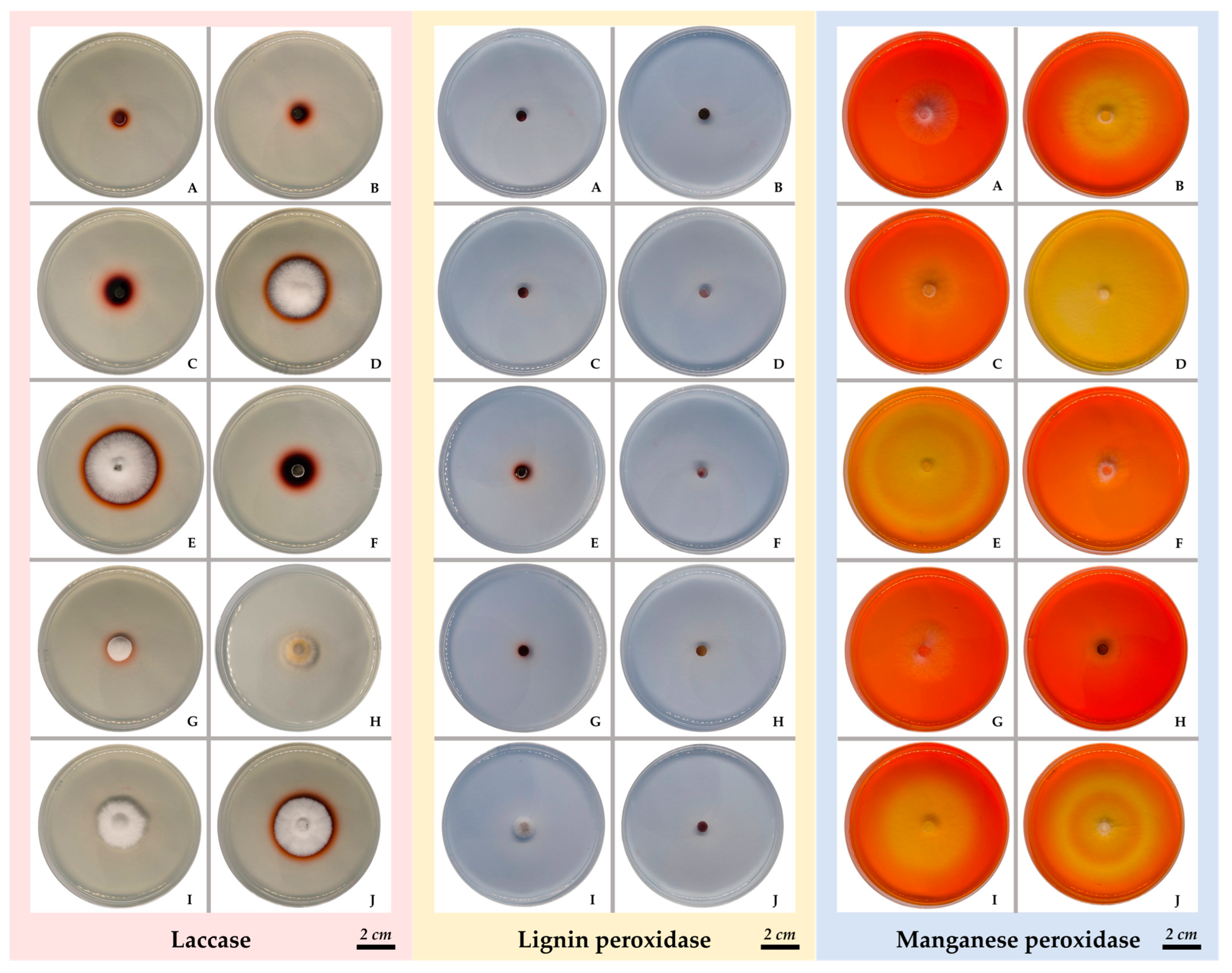
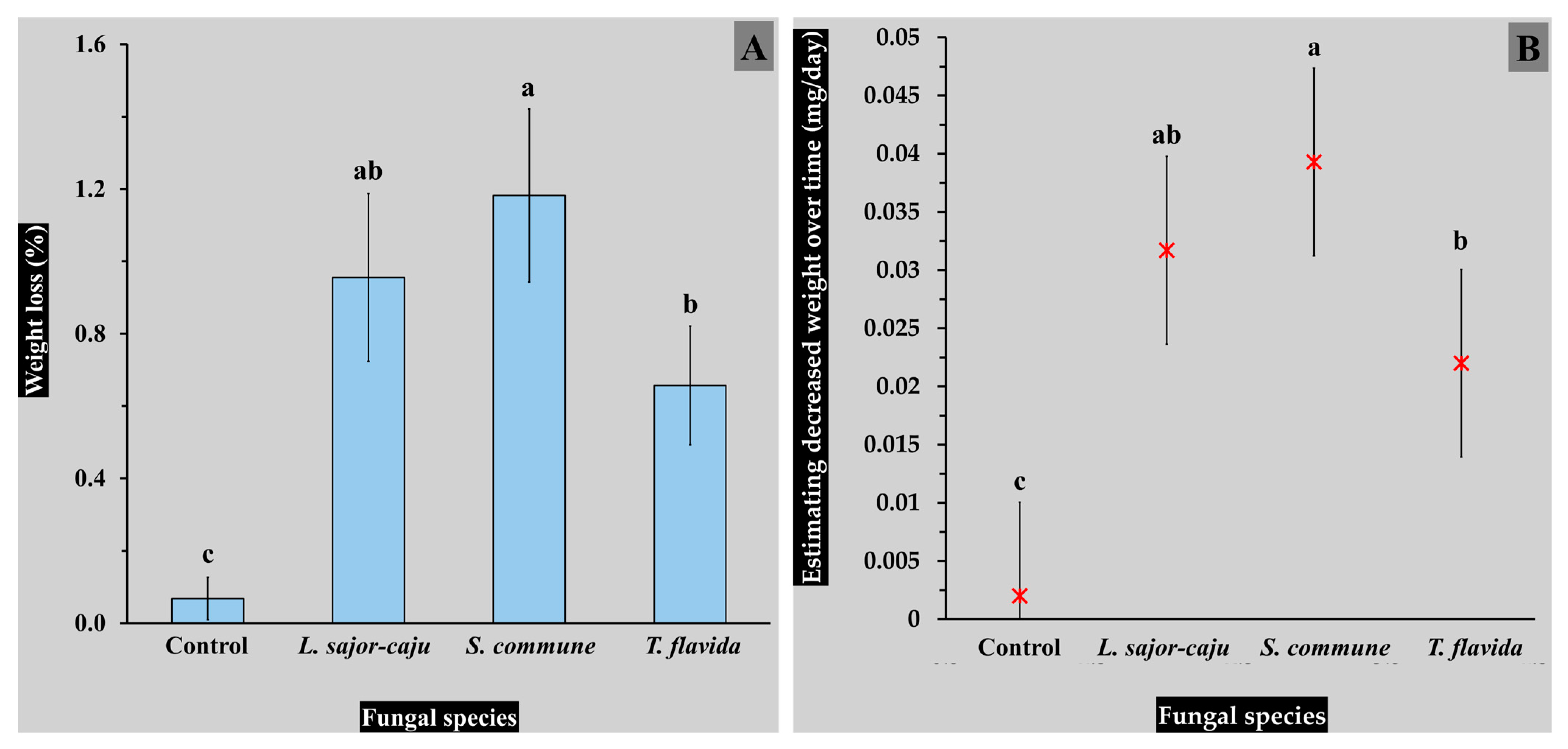

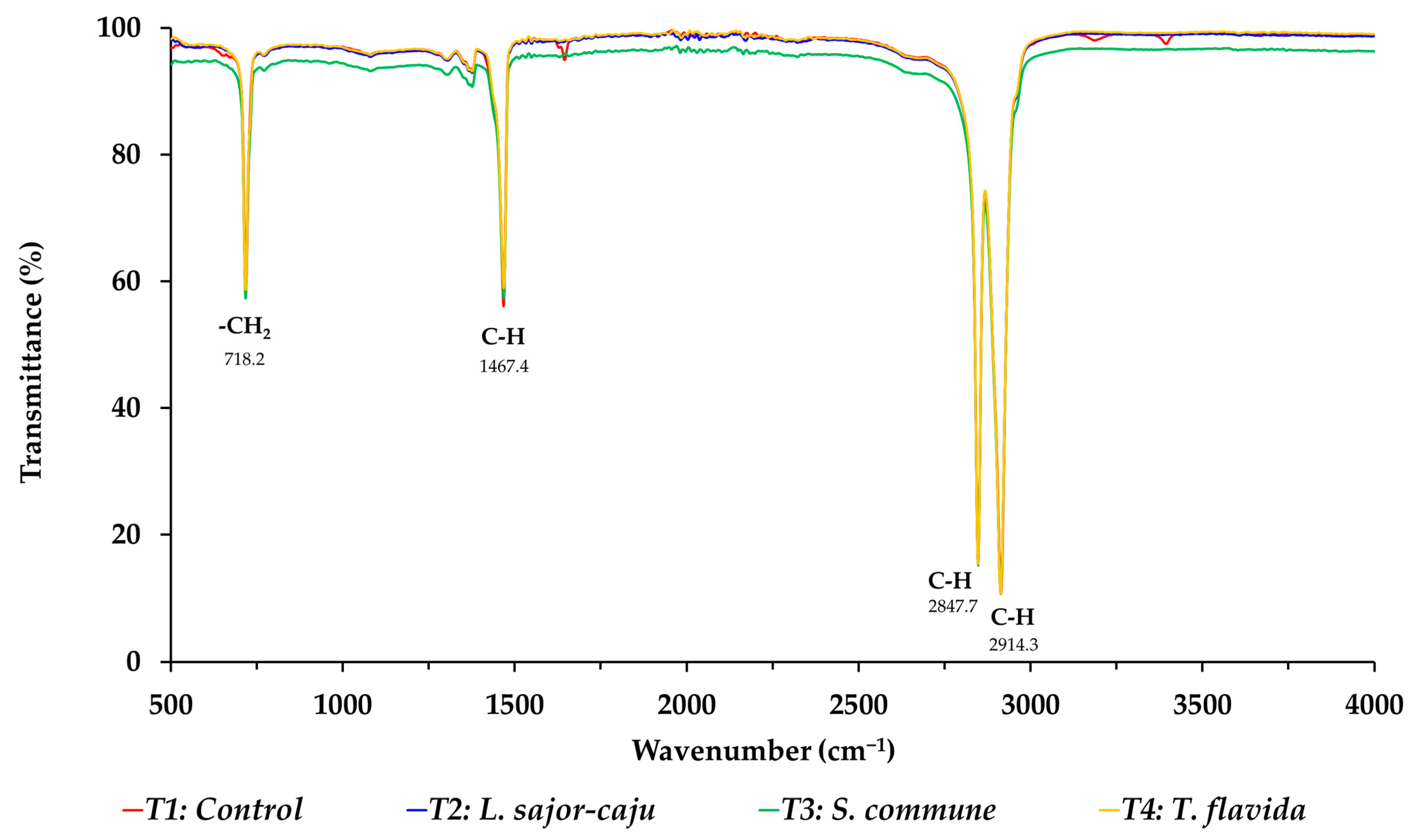
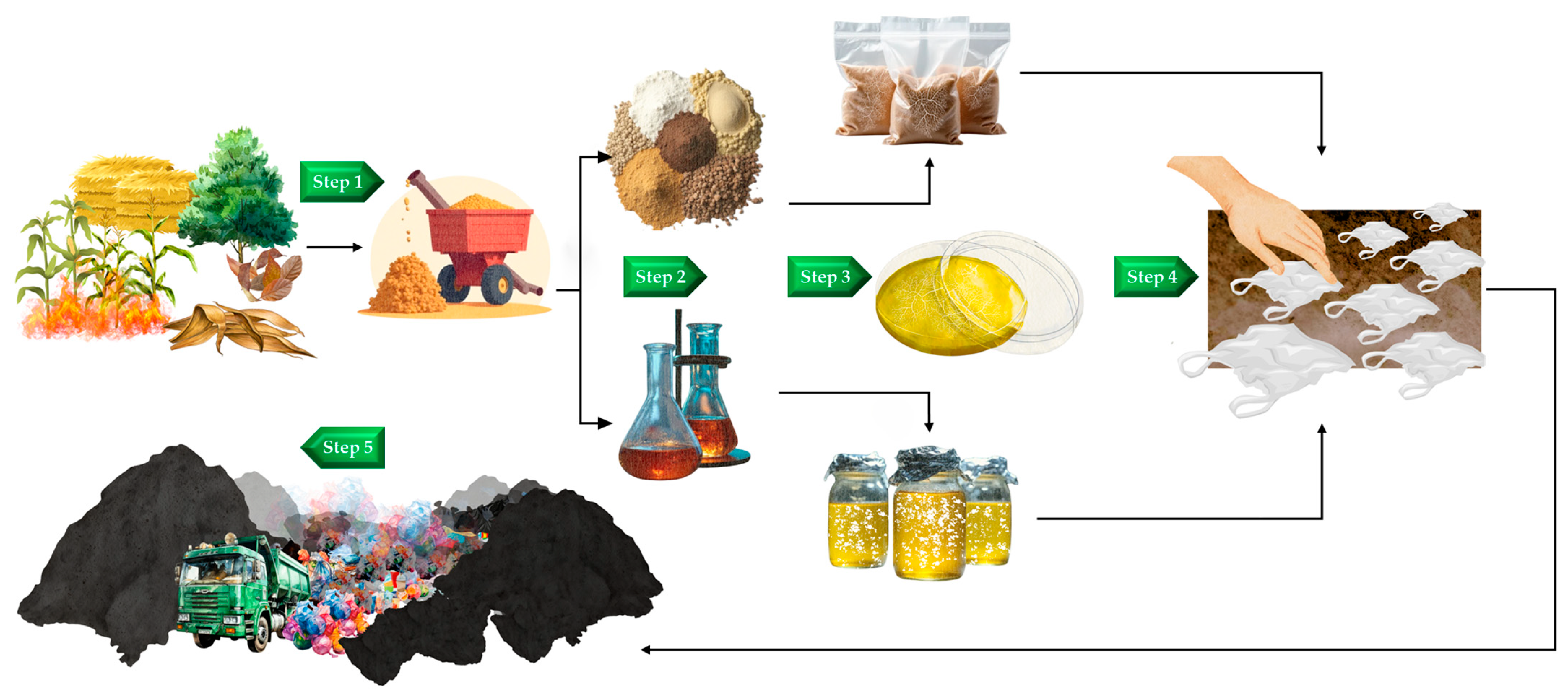
| Fungal Species | Rate of Mycelial Expansion (mm/Day) | Mycelial Dry Weight Estimation (mg) | Level of Mycelial Density |
|---|---|---|---|
| A. cylindracea TMCC-NO1 | 5.74 ± 0.09 h | 7.07 ± 1.33 f | ++++ |
| A. polytricha TMCC-NO8 | 11.82 ± 0.09 e | 72.87 ± 14.63 d | +++ |
| C. comatus TMCC-NO1 | 5.98 ± 0.91 gh | 9.17 ± 2.58 ef | ++ |
| L. sajor-caju TBRC6266 | 26.13 ± 0.91 a | 232.20 ± 15.98 b | ++++ |
| L. squarrosulus SDBR-CMU-WE001 | 19.50 ± 0.69 c | 166.60 ± 16.57 c | ++++ |
| M. crassa TMCC-NO1 | 6.70 ± 0.71 g | 28.70 ± 3.76 e | ++++ |
| P. conchatus SDBR-CMU-WE021 | 12.89 ± 0.28 d | 148.60 ± 9.37 c | ++ |
| P. linteus SDBR-CMU-WE058 | 9.03 ± 0.19 f | 25.73 ± 6.31 ef | +++ |
| S. commune SDBR-CMU-WE032 | 20.53 ± 0.06 b | 276.87 ± 16.79 a | ++++ |
| T. flavida SDBR-CMU-AM011 | 19.93 ± 0.06 bc | 232.70 ± 9.17 b | ++++ |
| Fungal Species | Enzymatic Index (EI) | ||
|---|---|---|---|
| Laccase | Lignin Peroxidase | Manganese Peroxidase | |
| A. cylindracea TMCC-NO1 | 1.04 ± 0.11 d | 0.00 ± 0.00 | 0.00 ± 0.00 d |
| A. polytricha TMCC-NO8 | 2.17 ± 0.89 c | 0.00 ± 0.00 | 0.00 ± 0.00 d |
| C. comatus TMCC-NO1 | 4.97 ± 0.50 a | 0.00 ± 0.00 | 0.00 ± 0.00 d |
| L. sajor-caju TBRC6266 | 0.33 ± 0.02 e | 0.00 ± 0.00 | 0.36 ± 0.02 a |
| L. squarrosulus SDBR-CMU-WE001 | 0.29 ± 0.01 e | 0.00 ± 0.00 | 0.17 ± 0.02 c |
| M. crassa TMCC-NO1 | 3.27 ± 0.42 b | 0.00 ± 0.00 | 0.00 ± 0.00 d |
| P. conchatus SDBR-CMU-WE021 | 1.14 ± 0.04 d | 0.00 ± 0.00 | 0.00 ± 0.00 d |
| P. linteus SDBR-CMU-WE058 | 0.00 ± 0.00 e | 0.00 ± 0.00 | 0.00 ± 0.00 d |
| S. commune SDBR-CMU-WE032 | 0.40 ± 0.03 e | 0.00 ± 0.00 | 0.28 ± 0.06 b |
| T. flavida SDBR-CMU-AM011 | 0.35 ± 0.10 e | 0.00 ± 0.00 | 0.35 ± 0.04 a |
| Cost-Efficiency and Economic Impact | Waste Management Methods | |||
|---|---|---|---|---|
| Incineration | Landfilling | Recycling | Fungi | |
| Initial setup cost | • High capital investments | • Low costs for the general filling pit, reclamation, orogeny; higher cost for sanitary landfill | • High implementation costs in management system • High energy cost • High oil cost • Affordability | • High initial costs associated with funding biotechnology facilities or research and development |
| Operational cost | • High cost ($36–578.5/ton) | • Low cost ($6.02−19/ton) | • High cost ($240–1800/ton) | • Low-cost solution for managing synthetic waste, fungal biodegradation requires specific growth media to produce enzymes, with costs depending on feedstock and local availability |
| Environmental impact | • If the flue gas is improperly treated, the secondary pollution will be very serious, whilst it can be controlled by advanced incineration or purification technology | • Pollutes the water and soil, which may affect wildlife and contribute to spreading harmful diseases • The secondary pollution of landfill leachate is serious and difficult to control | • High volumes of waste available • Environmental awareness | • Contribute to a bioremediation process more effective |
| Carbon emissions | • High carbon emissions as a result from burning plastic waste | • Moderate emissions in the biodegradation process | • Low to moderate emissions across the turning process | • Lower carbon emissions compared to traditional methods |
| Expected economic benefits | • Heat and electricity production leading to fewer emissions in the regular energy production sector • No sorting required, hence less expensive collection cost for solid wastes • Energy recovery | • Managing large volumes of plastic waste at low cost • Reducing transportation distances • Eliminating energy consumption. | • Avoidance of CO2 that otherwise would be emitted during incineration • Processing of materials which cannot otherwise, be recycled to value-add product • Production of new plastics and products which constitute good energy sources | • Utilizes living organisms, like fungi and bacteria, as a cost-effective and ecologically friendly method that could offer open business opportunities • A suitable waste disposal system and bio-remediation can improve local economies, provide employment, and support green technology innovation |
| Technical process | • Complicated | • Simple | • Complicated | • Simple |
| Limits | • High volumes to be processed per plant | • Slowly decomposes in landfill settings, requiring a large amount of area because of the rising rate from plastic waste disposal • Maintaining landfills in an ecologically friendly state for a long period is difficult | • Only applicable for selected plastic types collected in large volumes • Complex technology. • High volumes to be processed per plant | • Decomposition could require a long time • Its rate of decomposition mainly depends on pH, temperature, humidity, sunlight, UV radiation, and soil composition. • Different fungal species might exhibit varied specific substrates |
| Main causes | • Lack of space for landfilling • High demand and tariffs for electricity and hot water • Policy promotes incineration | • Lack of infrastructure • Poor administration • Insufficient rules | • Carbon credits • Policy promotes recycling | • Fungal biological potential (enzyme production) • Complies with the circular economy and sustainable waste management practices |
| References | [41,42,43,44,45,46] | [4,21,42,43,44,45,46,47,48] | [42,44,45,48] | [6,9,46,49,50] |
Disclaimer/Publisher’s Note: The statements, opinions and data contained in all publications are solely those of the individual author(s) and contributor(s) and not of MDPI and/or the editor(s). MDPI and/or the editor(s) disclaim responsibility for any injury to people or property resulting from any ideas, methods, instructions or products referred to in the content. |
© 2025 by the authors. Licensee MDPI, Basel, Switzerland. This article is an open access article distributed under the terms and conditions of the Creative Commons Attribution (CC BY) license (https://creativecommons.org/licenses/by/4.0/).
Share and Cite
Aiduang, W.; Jatuwong, K.; Ratanapong, K.; Promjaidee, T.; Xayyavong, O.; Hongsanan, S.; Lumyong, S. Breaking Down Linear Low-Density Polyethylene (LLDPE) Using Fungal Mycelium (Part A): A Path Towards Sustainable Waste Management and Its Possible Economic Impacts. Life 2025, 15, 755. https://doi.org/10.3390/life15050755
Aiduang W, Jatuwong K, Ratanapong K, Promjaidee T, Xayyavong O, Hongsanan S, Lumyong S. Breaking Down Linear Low-Density Polyethylene (LLDPE) Using Fungal Mycelium (Part A): A Path Towards Sustainable Waste Management and Its Possible Economic Impacts. Life. 2025; 15(5):755. https://doi.org/10.3390/life15050755
Chicago/Turabian StyleAiduang, Worawoot, Kritsana Jatuwong, Kingkarn Ratanapong, Thanaporn Promjaidee, Orlavanh Xayyavong, Sinang Hongsanan, and Saisamorn Lumyong. 2025. "Breaking Down Linear Low-Density Polyethylene (LLDPE) Using Fungal Mycelium (Part A): A Path Towards Sustainable Waste Management and Its Possible Economic Impacts" Life 15, no. 5: 755. https://doi.org/10.3390/life15050755
APA StyleAiduang, W., Jatuwong, K., Ratanapong, K., Promjaidee, T., Xayyavong, O., Hongsanan, S., & Lumyong, S. (2025). Breaking Down Linear Low-Density Polyethylene (LLDPE) Using Fungal Mycelium (Part A): A Path Towards Sustainable Waste Management and Its Possible Economic Impacts. Life, 15(5), 755. https://doi.org/10.3390/life15050755








